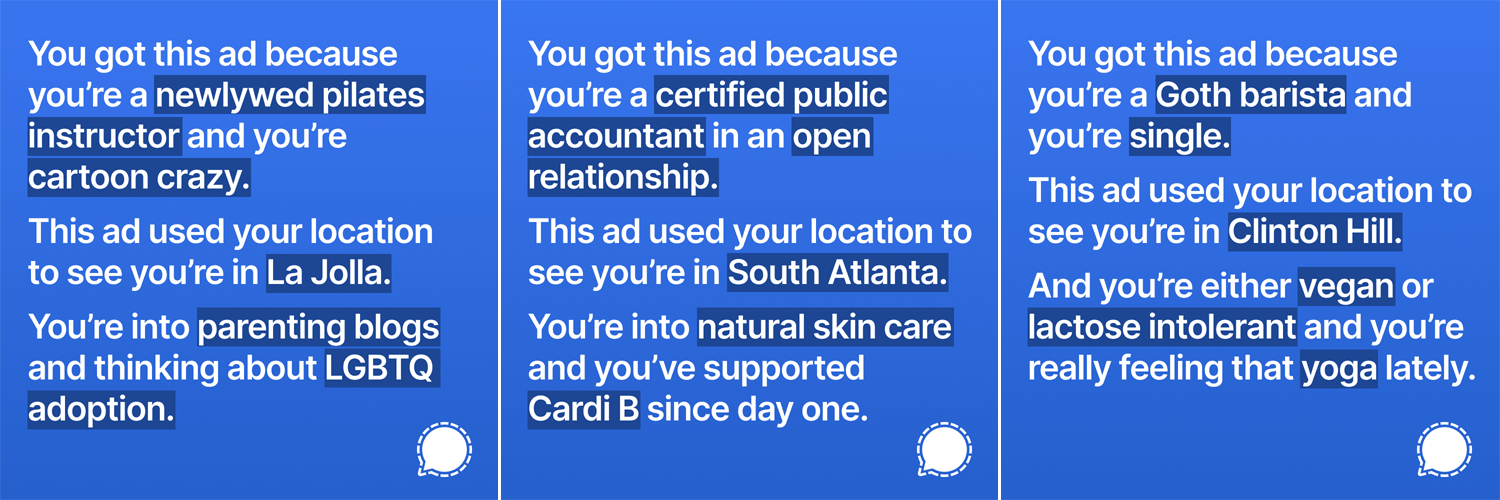Most of our readers are well aware of the fact that the big tech corporations, especially those that run social media know a great deal about us and our behavior. But it rarely hits home how much personal data they have about us and how they can guess, quite correctly, even more. Lots more.
Signal came up with an idea to drive that point home. A simple but very effective idea, nothing short of genius. They bought advertising space on Instagram and showed visitors ads full of the characteristics that were used to target them.

In an a blog post, the company explains what it tried to do and how Facebook banned their ads. While they only tried to demonstrate that Facebook’s own tools have the potential to divulge what is otherwise unseen.
About Signal
Signal is a privacy-focused messaging app that has picked up a lot of new users recently, after rival WhatsApp made an unpopular change to its privacy policy. It has made the news on several occasions after being asked by governments to hand over user data. It has always declined, stating that it does not record the data it is being asked to produce. The company says that it keeps minimal records about its users and all Signal messages and voice calls are end-to-end encrypted.
The many faces of Facebook
The US-based photo and video sharing social networking Instagram was acquired by Facebook in 2012. Facebook also developed and runs Facebook Messenger, a messaging app and platform. Facebook also owns WhatsApp, a massively popular messaging service that allows users to send text messages and voice messages, and with that is a direct competitor to Signal.
The contrast
The very different ways these two companies deal with user data while being active on the same playing field explains some of the animosity between the two. And Signal has never shied away from criticizing other companies it thinks are compromising users’ privacy or security. (I’m not even mentioning that Facebook introduced a discovery and curation tool called, you guessed it, Signal for Facebook and Instagram.)
The user data
All this does not take away from the fact that I would have loved to see the effect on Facebook users if these ads had been allowed to run. Would it have outraged users? Because seeing that sort of personal information displayed on a website really hits home. Could they even have scared users away from commercial social media? Let’s not forget that not only does Facebook gather that data, it also sells it to advertisers, as Signal tried to point out with its campaign.
What you share
Recently we have warned our readers against the worst possible info you could share on social media. And those are the ones that are the things that are easy to understand and follow once you see the dangers. But all the small details that you give away in your posts matter too. Taken together they can amount to a thorough customer profile that is valuable for advertisers. Knowing where your interests lie allows them to spend their advertising dollars more effectively.
Advertising on social media
Advertising is a straightforward way for social media networks to not only make money from the data they’ve collected—by offering ad space to advertizers, but also by allowing external parties to potentially dip into the same pool. Unlike traditional publishing, social media ads can be tailored, based on personalized data the social network sees you searching for, talking about, or liking daily.
If you thought hitting “like” (or its equivalent) on a website was simply a helpful thumbs up in the general direction of someone providing content, think again. Even if you don’t click like, if you’re a Facebook user and you’ve not logged out then Facebook knows you’ve visited that web page. And if you click “like”, it also knows that you liked that page. All of which feeds data into the big pot of “These are the ads we should show this person”, even when you’re not actually using Facebook.
Guessing the rest about you
What they know about you can be topped off by what they can guess about you. Guesses are based on the interests of you, your family, your friends, and your friends’ friends, plus other demographic clues, such as your job title, pictures of your home, travel experiences, cars, and marriage status. All of these data points help the social network figure out which specific adverts to send your way. And they offer this information readily to their customers, the advertisers.
They just don’t want you to see it in the ads.










